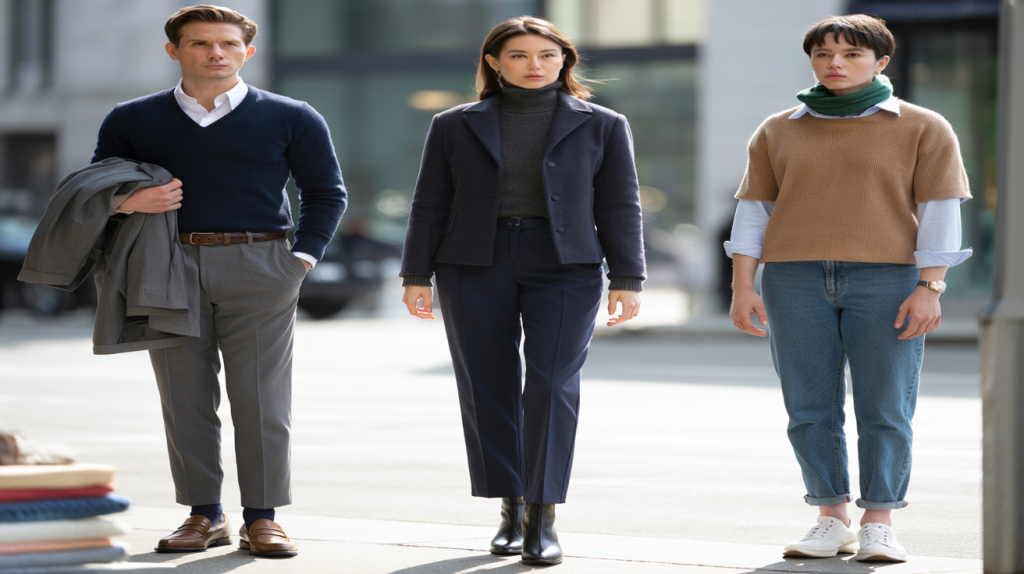Stop bulky or boring knits. Learn exactly how to wear a sweater: fit, layering formulas, color tricks and care, with expert facts to keep yours sharp longer.
Clicked for quick, real advice on how to wear a sweater that actually flatters. Here it is. Start with the right fit, choose the fabric for the day, then layer with intent. A crew neck keeps things clean, a V neck opens space for a collar, a turtleneck frames the face. Hem should meet top of the hip, shoulder points align with your shoulders, cuffs kiss the wrist. Immediate results.
The next move changes everything. Think fabric first. Merino regulates temperature at the office, cotton feels easy and matte, cashmere adds softness, and lambswool brings structure. Wool can absorb up to 30 percent of its weight in moisture without feeling wet, according to The Woolmark Company, which explains why good knits stay comfortable on a commute. From there, layering is not decoration. It is proportion, texture and a clear outfit plan.
How to wear a sweater : fit, fabric and occasion
Most style mistakes come from fit. A sweater that pulls across the chest or puddles at the hem looks tired. Aim for light drape along the torso, no ripples at the shoulders, and sleeves that end right at the wrist bone. On skirts or tailoring, stop the hem at the top of the hip to keep legs looking longer.
Fabric sets the mood. Fine gauge merino slides under a blazer without bulk. Midweight cotton suits weekends and travel. Cashmere reads polished at dinner because the surface is slightly lustrous. Chunky rib or Aran stitches add volume, so balance them with slimmer trousers or a pencil skirt. That trade-off keeps the silhouette calm, not boxy.
Context matters. Office days call for solid crew necks in navy, charcoal or camel. Casual plans welcome stripes, half zips and sportier textures. For a cool restaurant, a dark turtleneck is the simplest upgrade. One piece, strong impact, zero effort for any occassion.
Layering a sweater with shirts and jackets
Layering starts with the collar. Under a crew neck, choose an oxford or poplin with a soft roll so the neckline stays smooth. Under a V neck, a button-down collar stands neatly without wandering. Let the shirt cuff show a sliver past the knit to give the wrist definition.
With tailoring, keep bulk in check. A fine merino or cashmere crew neck sits cleanly under a structured jacket, while a chunky fisherman knit lives better under a relaxed coat. Textures should step up or down in clear order: smooth shirt, soft knit, crisp jacket, then a textured scarf if needed.
Cardigans do double duty as outerwear and mid-layer. Leave the top and bottom buttons open to keep the line long. A sweater vest changes proportions instantly, warming the core while freeing the arms. It also spotlights a patterned shirt without visual noise.
Try these quick formulas that rarely miss :
- Dark turtleneck, tailored jacket, clean trousers, low boots
- Crew neck, oxford shirt, straight jeans, white sneakers
- V neck, crisp shirt, wool trousers, loafers
- Chunky knit, slim chinos, sturdy derbies
Colors, prints and accessories with sweaters
Color sets the tone before anyone notices stitching. Neutrals like navy, grey, black, camel and cream mix with everything and photograph well. Add one accent at a time: forest green, burgundy, rust, or cobalt against those neutrals looks modern without trying too hard.
Patterns deserve scale control. Fair Isle or Nordic motifs feel right when the rest of the outfit goes quiet. Fisherman cables add depth on camera, so they shine in winter light. If the knit is busy, keep the shirt plain. If the knit is plain, try a thin stripe or microcheck beneath.
Small accessories lock the look. A leather belt in the same color family as shoes unifies the lower half. A soft scarf near the face lifts a simple crew neck. Minimal jewelry pairs best with heavier knits so nothing snags.
Care that keeps sweaters soft : wash less, de-pill right, dry flat
Clothes last longer when cared for gently. McKinsey and Company reported in 2016 that people bought 60 percent more clothing in 2014 than in 2000 while keeping each item about half as long. Wearing knits more times between washes and storing them flat stretches their lifespan without any style sacrifice.
Washing guidance is simple. Turn the sweater inside out, use cool water and a wool or delicate cycle, then lay flat on a towel to dry. Heat and spin stretch fibers. A cashmere comb or fabric shaver removes pills quickly after the first few wears so the surface stays smooth.
There is also an environmental upside. The International Union for Conservation of Nature estimated in 2017 that synthetic textiles release about 35 percent of primary microplastics found in the oceans. A University of Plymouth study in 2016 measured up to 700,000 microfibers shed in a single domestic wash of synthetics. Airing a sweater, spot cleaning, then washing only when needed reduces shedding, saves energy, and keeps shape and color intact.
One last fix that changes daily comfort. Because wool manages moisture so well, a light merino turtleneck under a coat often replaces a bulky hoodie. Less bulk means cleaner lines. Test one outfit this week and feel how the whole look settles into place.
